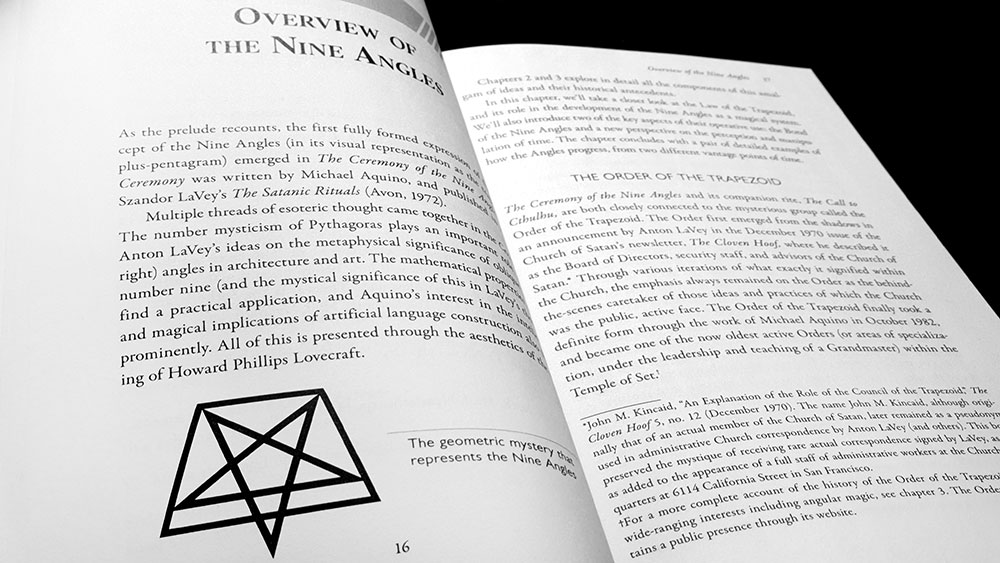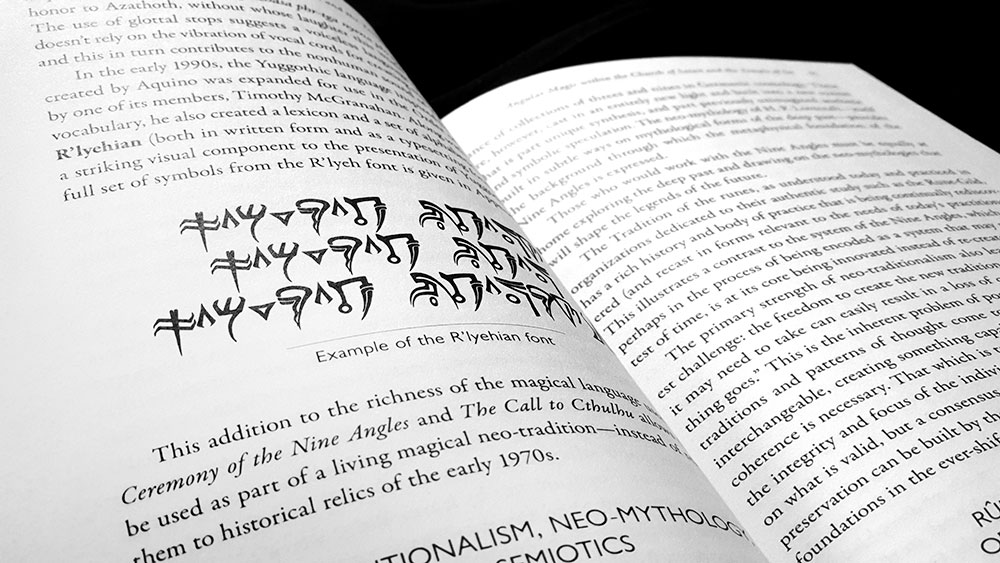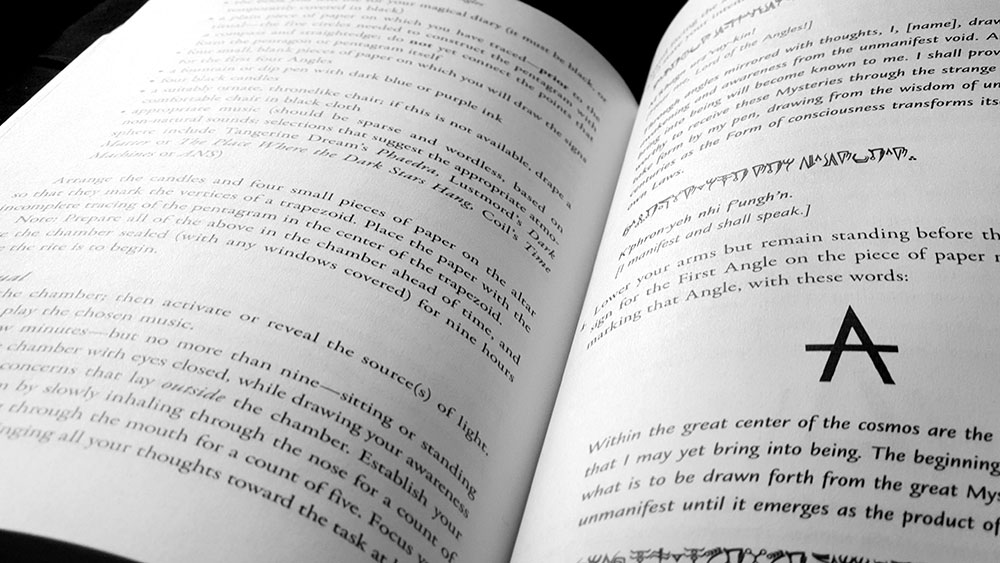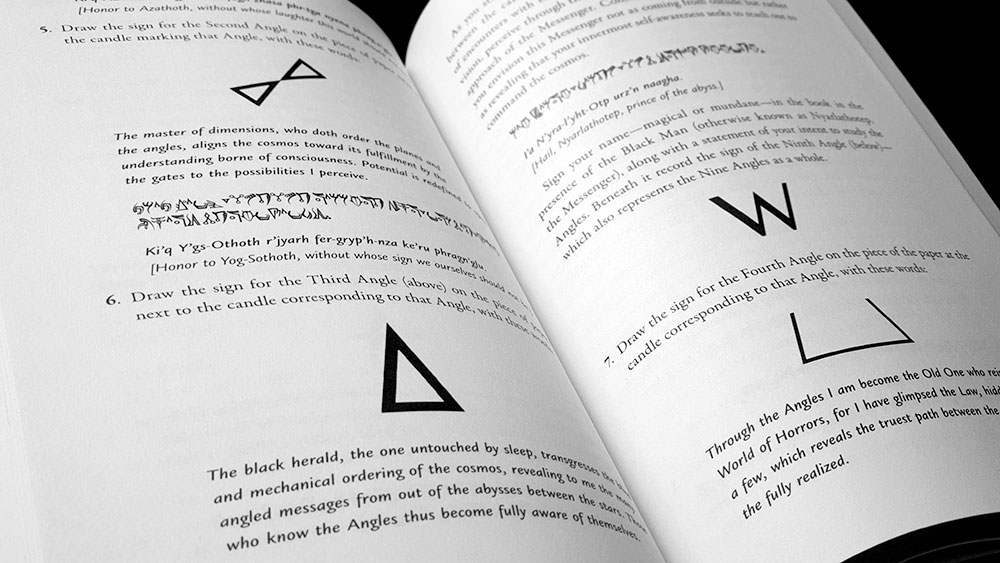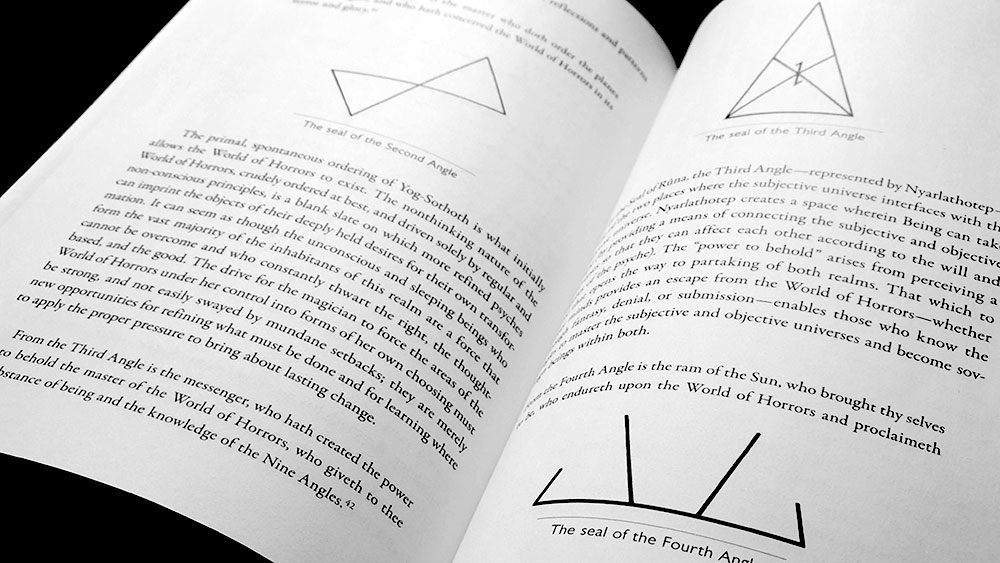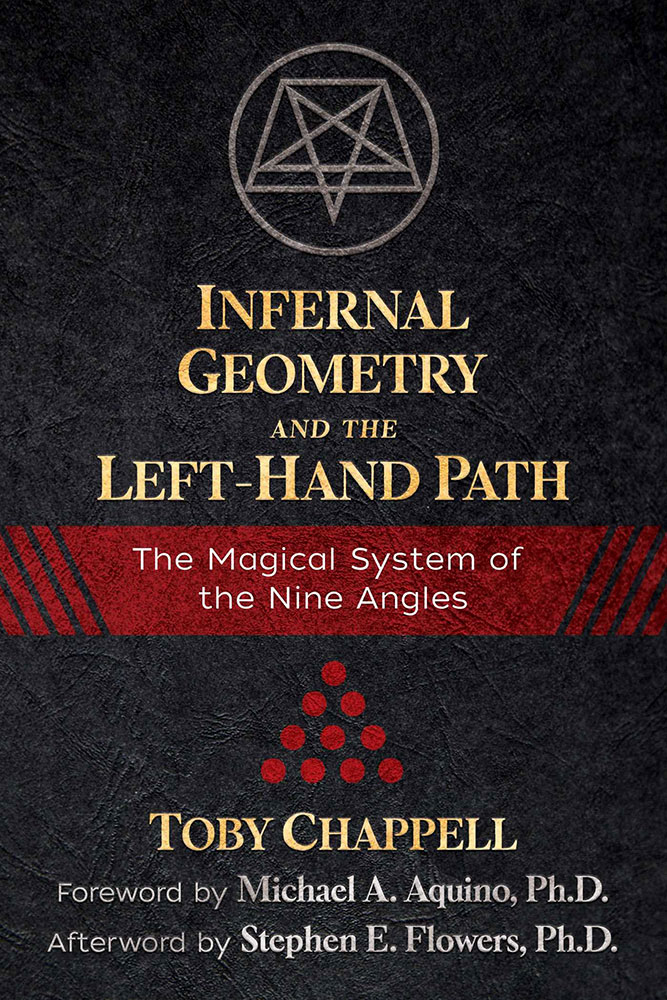 In his recently-reviewed History of the Rune-Gild, Stephen Flowers tells how his interest in the Church of Satan was originally piqued by enigmatic references in their literature to the nine angles. This interest was then extended to the Temple of Set, which Flower joined, and whose founder, Michael Aquino, had originally written the Ceremony of the Nine Angles that was included in Anton LaVey’s The Satanic Rituals. Flowers would rise to become the grand master of the Temple of Set’s inner Order of the Trapezoid, and now, several decades later, both he and Aquino bookend this book from the current grand master of the Order of the Trapezoid, Toby Chappell, providing foreword and afterword respectively to a thorough exploration of what the subtitle refers to as “the magical system of the Nine Angles.”
In his recently-reviewed History of the Rune-Gild, Stephen Flowers tells how his interest in the Church of Satan was originally piqued by enigmatic references in their literature to the nine angles. This interest was then extended to the Temple of Set, which Flower joined, and whose founder, Michael Aquino, had originally written the Ceremony of the Nine Angles that was included in Anton LaVey’s The Satanic Rituals. Flowers would rise to become the grand master of the Temple of Set’s inner Order of the Trapezoid, and now, several decades later, both he and Aquino bookend this book from the current grand master of the Order of the Trapezoid, Toby Chappell, providing foreword and afterword respectively to a thorough exploration of what the subtitle refers to as “the magical system of the Nine Angles.”
As this initial cast of characters suggests, this is a book that considers ideas from the Church of Satan and the Temple of Set, but it goes beyond this to touch on the geometry of Pythagoras, runic symbolism, as well as the mysticism of the Germanic revival (such as that of Karl Maria Wiligut), and the weird literature of Howard Philip Lovecraft, Frank Belknap and related authors. Indeed, Lovecraft and his genre of cosmic horror looms large within these pages, with the Church of Satan’s Ceremony of the Nine Angles, which acts as a frequent reference throughout the book, being an invocation of the entities from his eldritch cosmology.
These nine angles are represented visually here by an isosceles trapezoid within which sits an slightly irregular inverted pentagram, its two uppermost points touching the top corners of the trapezoid, and its horizontal line sitting just above the quadrilateral’s lower line, through which the lower tip of the pentagram breaks. The angles nine are, thus, found at the four points of the trapezoid and the five points of the pentagram, and each of these is assigned a keyword or concept so that the design forms a psychocosm comparable to the qabbalistic tree of life or the septenary Tree of Wyrd. These keywords map out the stages of a journey that can be applied to anything, be it magic, cosmology or the creation of a piece of art, beginning with chaos, ending with perfection, and along the way meeting order, understanding, being, creation, sleep, awakening and re-creation. In this way, and as noted by Chappell in discussing other uses of the number nine and mystical geometry, this infernal set of nine angle resembles the enneagram popularised by Gurdjieff as a model of human psychological types and processes; though, it must be said, that the nine-pointed star-esque enneagram, despite looking like its bottom has fallen out, is more aesthetically pleasing than the awkward pentagram and trapezoid combo used here.
For someone who never found trapezoids all that magickally appealing (come on, it’s a slopey rectangle, go tetrahedrons!), there was always the suspicion that the shape and the extra five angles needed to make up the nine angles had been picked somewhat arbitrarily, and therefore any attempt to assign meaning to it was effectively occult reverse engineering. If that’s the case, then well done Mr Chappell, as Infernal Geometry and the Left-Hand Path spends a lot of time shoring up the significance of the nine angles, and uses the work of previous grandmasters of the Order of the Trapezoid (Aquino, Flowers and Patricia Hardy) as the theoretical grounding.
One of the book’s first deeper considerations of the angles and their keywords returns once more to the Ceremony of the Nine Angles and assigns to the four angles of the trapezoid the big four of Lovecraftian cosmology: Azathoth, Yog-Sothoth, Nyarlathotep and Shub-Niggurath. This does give one pause because this means they signify respectively the stages of chaos, order, understanding and being, when surely it should just be chaos, chaos, chaos and even more chaos but with goats. Obviously, this is a somewhat dated bone to pick, considering the Ceremony of the Nine Angles was published in 1972, but the image here (and in a lot of subsequent Lovecraft-inspired occultism) of the Old Gods as spooky but largely benevolent gods who can be invoked for one’s self-improvement, flies in the face of Lovecraft’s vision for his creations. When the Outer Gods and Great Old Ones are often depicted as having the kind of disregard for humanity that a mammoth would have for a flea, it takes some wilful misreading of Lovecraft to turn them into beings who can, in the case of Yog-Sothoth, be asked to “guide us through the night of thy creation, that we may behold the Bond of the Angles and the promise of thy will.” At best, Lovecraft’s Chthulhu mythos seems a better fit for an anti-cosmic system, in which the only reason any adherent would address them is so that the cosmos and all creation can disintegrate into a gibbering mass of madness and non-being.
This bone-picking has to be pushed aside, though, as Lovecraftian-inspired cosmology and Aquino’s interpretation of it plays a significant role in the contents of the book; so much so that it could almost have been mentioned in the title. And it is Aquino’s Ceremony of the Nine Angles, along with his Call to Cthulhu and LaVey’s Die Elektrischen Vorspiele, that form the lion’s share of the content here, with Chappell providing perhaps too thorough an analysis of the three rites, constantly returning to them as the touchstones of this angular magic. Along with this is a restatement of the principles of satanic magic as put forth by LaVey in The Satanic Bible and The Satanic Rituals, and so, for anyone with some experience in this here occult milieu, things can feel very familiar, and just a little dated, with this canonisation of magical theory from the 1970s.
When it comes to examples of angular ritual work separate from the three ritual prototypes, things are remarkably conventional. Despite all the talk of the angles as a unique system, and the promise in Lovecraft’s fiction of a different, reality-distorting approach to ritual, what is presented here is the same old stuff. Yes, there’s now enneadic symbolism to employ, instead of, say, a standard calling of quarters, but otherwise it’s just the usual stuff: light some candles, draw some symbols, say some things, oh, and sit on a throne. Said symbols, geometric shapes representing each angle and referred to as signs of the nine angles, are inconsistent in weight and appearance, as are another set of nine figures that are designated as seals of the angles rather than signs. Neither set are particularly appealing aesthetically, feeling awkward and unremarkable, and certainly unworthy of the sense of mystery felt by Robert Blake in The Haunter of the Dark. One could sympathetically say that this lack of appeal fulfils the brief of the Lovecraftian angles being strange and unsettling (because the lack of design consistency unsettles this reviewer) but really it feels like a missed opportunity. While yes, Lovecraft, despite wishful thinking to the contrary, had the benefit of writing fiction with all the license that provides, no one in occultism seems to have quite managed to replicate his ideas of geometry that has an indefinable wrongness that allows space and time itself to open up. The ritual chambers used here, based on the original Church of Satan instructions from the 1970s, for example, basically specify no curved surfaces as the extent of angular concerns (and I can’t imagine that many ritual spaces are overflowing with such anyway), rather than anything like the mind and time-altering non-Euclidean geometry explored by the witch Keziah Mason in The Dreams in the Witch House.
Chappell writes with a capable and effortless-style throughout Infernal Geometry and the Left-Hand Path, using a measured delivery that often belies the occult nature of the subject material. It does feel longer than it should be, with the main content alone, sans appendices, running to over 240 pages. Part of this is due to a degree of repetition and recapping, with angular seals, and the trapezoid and trapezoid-pentagram combo being printed in multiple instances, ritual refrains repeated in full across multiple rituals, and main points in the body text being restated for the sake of a little too much thoroughness.
Infernal Geometry and the Left-Hand Path concludes with a substantial series of appendices, six in all, providing significant source documents, as well as the first complete publication of an aesthetically pleasing R’lyehian alphabet, created in 1992 by a knight of the Order of the Trapezoid, Sir Tmythos. The other appendices provide something of a hoard of angular mysticism, with several key texts that precede Chappell’s meisterwerk from the hands of Aquino, Flowers and Hardy. Aquino provides two pieces: an article on Lovecraftian ritual and his version of a Lovecraftian language, with a handy glossary (originally printed in the weird fiction zine Nyctalops), and a commentary on the seal of the nine angles and the symbolism of each angle (published in May 1988 in Runes, the private journal of the Order of the Trapezoid). These elements are also explored, first by Flowers in an article from the March 1998 issue of Runes, and by Hardy in a piece called Keystone from 1992. Meanwhile, Flowers’ contribution, also from Runes and previously republished in his anthology Black Runa, is The Alchemy of Yggdrasil in which he first discusses elemental concepts in northern cosmology and creation before relating these to the idea of angular magic.
For those wondering if, with all this talk of nine angles, the similarly named Order thereof gets a mention, the answer is no; which is perhaps to be expected given the contentious exchanges between Aquino and the ONA’s Anton Long in the 1990s. However, with the second chapter’s discussion of various instances of enneadic symbolism from other mystical traditions, the absence of any mention of, for example, the Order of Nine Angle’s Rite of Nine Angles seems a significant omission. With that said, there’s something a little thrilling about seeing a book like this, with Satanism and Setianism mentioned so nonchalantly on the rear cover blurb (let alone within the pages themselves), published by a relatively mainstream publisher like Inner Traditions. It’s not this specific publisher’s first foray into darkness, with Flowers’ Lords of the Left Hand Path being perhaps the first and best example, and similarly, the main titles of the Church of Satan were obviously available as Avon’s mass market paperbacks before this. The professionally presented works of Inner Traditions seem a respectable step up from the insular world of preach-to-the-choir occult publishing, though, and Chappell joins the ranks of Flowers and Don Webb as published Setian authors of note, thereby highlighting the Temple of Set as an occult order that can get authoritative and fairly rigorous works published and made available to a broad market. Mmmm, that’s good dialectics.
Text design and layout for Inner Traditions are once again expertly handled by Debbie Glogover who uses the now seemingly standard combination of Garamond and Gill Sans for body and subtitles respectively. Titles are in Adam Ladd’s lovely hand-drawn serif face Botany, while Tide Sans by Kyle Wayne Benson gets a tiny shout out for its subtle use in chapter numbers
Published by Inner Traditions
The soundtrack for this review is Lustmord – The Place Where the Black Stars Hang, one of several dark ambient works suggested as a ritual soundtrack by Chappell.
